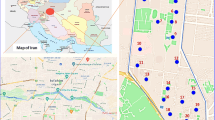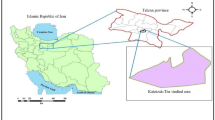Abstract
Radiation is a natural part of the environment that people interact continuously, and radon is one of the most important sources because of its abundance and mobility. Due to gas form, radon can reach and accumulate in living places easily. Inhalation of radon and its progenies is an important risk factor for health hazards. Accurate measurement of radon levels is quite essential for the dose evaluation of radon exposure in buildings. In this study, radon activity measurements have been performed by using AlphaGUARD portable radon detector at several locations in Akfirat campus of Istanbul Okan University. Annual effective doses were calculated by using ICRP regulations for various exposure periods.







Similar content being viewed by others
References
Akkurt İ (2009) Effective atomic and electron numbers of some steels at different energies. Ann Nucl Eng 36(11-12):1702–1705. https://doi.org/10.1016/j.anucene.2009.09.005
Akkurt İ, Uyanik NA, Günoğlu K (2015) Radiation dose estimation: an in vitro measurement for Isparta-Turkey. IJCESEN 1–1:1–4. https://doi.org/10.22399/Ijcesen.194376
Aközcan S (2014) Annual effective dose of naturally occurring radionuclides in soil and sediment. Toxicol Environ Chem 96:379–386. https://doi.org/10.1080/02772248.2014.939177
Çetin B, Öner F, Akkurt I (2016) Determination of natural radioactivity and associated radiological hazard in excavation field in Turkey (Oluz Höyük). Acta Phys Pol A 130(2016):475–478. https://doi.org/10.12693/APhysPolA.130.475
Demir N, Kıvrak A, Üstün M, Cesur A, Boztosun I (2017) Experimental study for the energy levels of Europium by the Clinic LINAC. IJCESEN 3-1:47–49
Durrani SA, Ilic R (1997a) Radon measurements by etched track detectors: applications in radiation, earth sciences and environment. In: Saeed A (ed) Durrani and Radomir Ilic, World Scientific, Singapore, p 163
Durrani S A, Ilic R (1997b) Radon measurements by etched track detectors: applications in radiation, Earth sciences and environment. In: Saeed A (ed) Durrani and Radomir Ilic, World Scientific, Singapore, 387p
Google Earth (2018) US Dept. of State Geographer 2018 Google Image Landsat
Günay O (2018) Determination of natural radioactivity and radiological effects in some soil samples in Beykoz-Istanbul. Eur J Sci Technol 12:9–14 ISSN:2148–2683
Günay O, Saç MM, Içhedef M, Taşköprü C (2018a) Natural radioactivity analysis of soil samples from Ganos Fault (GF). Int J Environ Sci Technol. Print ISSN: 1735-1472, Online ISSN, 1735–2630
Günay O, Saç MM, Içhedef M, Taşköprü C (2018b) Soil gas radon concentrations along the Ganos Fault (GF). Arab J Geosci 11:213. Print ISSN: 1866–7538. https://doi.org/10.1007/s12517-018-3542-2
ICRP (1990) Publication 60, Recommendations of the International Commission on Radiological Protection, in ICRP Publication 60. Pergamon Press Annals of ICRP, Oxford
Kara U, Kara Y, Akkurt I (2016) A study on radiation in operating room in Suleyman Demirel University. Acta Phys Pol A 129(1):401–403. https://doi.org/10.12693/APhysPolA.129.401
Kara U, Yildiz M, Akkurt I (2017) Investigation of radiation exposure dose from nuclear medicine procedures (Tc-99m MAG-3). Acta Phys Pol A 132(3):883–885. https://doi.org/10.12693/APhysPolA.132.883
Kemski J, Klingel R, Siehl A, Valdivia-Manchego M (2009) From radon hazard to risk prediction-based on geological maps, soil gas and indoor measurements in Germany. Environ Geol 56(7):1269–1279. https://doi.org/10.1007/s00254-008-1226-z
Kulalı F, Akkurt İ (2015) Investigation of radon concentrations in Pamukkale-Turkey. https://doi.org/10.12693/APhysPolA.128.B-445
Kulalı F, Tsvetkova T, Akkurt İ, Suiatin B, Nevinsky I (2014) Simultaneous measurement of groundwater radon in a large area: first results. J Sci Res Rep 3(18):2415–2421 Article no. JSRR.2014.18.004 SCIENCEDOMAIN international
Kuluöztürk M F, Büyüksaraç A, Özbey F, Yalçın S, Doğru M (2018) Determination of indoor radon gas levels in some buildings constructed with Ahlat stone in Ahlat/Bitlis. Int J Environ Sci Technol 1–6. https://doi.org/10.1007/s13762-018-1692-0
Mavi B, Akkurt I (2010) Natural radioactivity and radiation hazards in some building materials used in Isparta, Turkey. Rad Phys Chem 79(9):933–939. https://doi.org/10.1016/j.radphyschem.2010.03.019
Mnich Z, Karpinska M, Kapala J, Kozak K, Mazur J, Birula A, Antonowicz K (2004) Radon concentration in hospital buildings erected during the last 40 years in Białystok. Poland J Environ Radioact 75:225–232
Seçkiner S, Akkurt I, Günoglu K (2017) Determination of 40K concentration in gravel samples from Konyaaltı Beach, Antalya. Acta Phys Pol A 132(3-II):1095–1097. https://doi.org/10.12693/APhysPolA.132.1095
TAEA (2010) Environmental radioactivity monitoring in Turkey. Technique Report, Ankara, pp 9–14
UNSCEAR (2000) United Nations Scientific Committee on the Effects of Atomic Radiation, Sources and Biological Effects of Ionizing Radiation United Nations, New York
Uyanık NA, Uyanık O, Akkurt I (2013) Micro-zoning of the natural radioactivity levels and seismic velocities of potential residential areas in volcanic fields: the case of Isparta (Turkey). Journal of Applied Geophysics, Volume 98(2013):191–204 ISSN 0926-9851, https://doi.org/10.1016/j.jappgeo.2013.08.020
World Health Organization (2010) WHO guidelines for indoor air quality: selected pollutants. Publications WHO Regional Office for Europe Scherfigsvej 8 DK-2100 Copenhagen , Denmark, ISBN 978 92 890 0213 4
Author information
Authors and Affiliations
Corresponding author
Additional information
This article is part of the Topical Collection on Geo-Resources-Earth-Environmental Sciences
Rights and permissions
About this article
Cite this article
Günay, O., Aközcan, S. & Kulalı, F. Measurement of indoor radon concentration and annual effective dose estimation for a university campus in Istanbul. Arab J Geosci 12, 171 (2019). https://doi.org/10.1007/s12517-019-4344-x
Received:
Accepted:
Published:
DOI: https://doi.org/10.1007/s12517-019-4344-x




